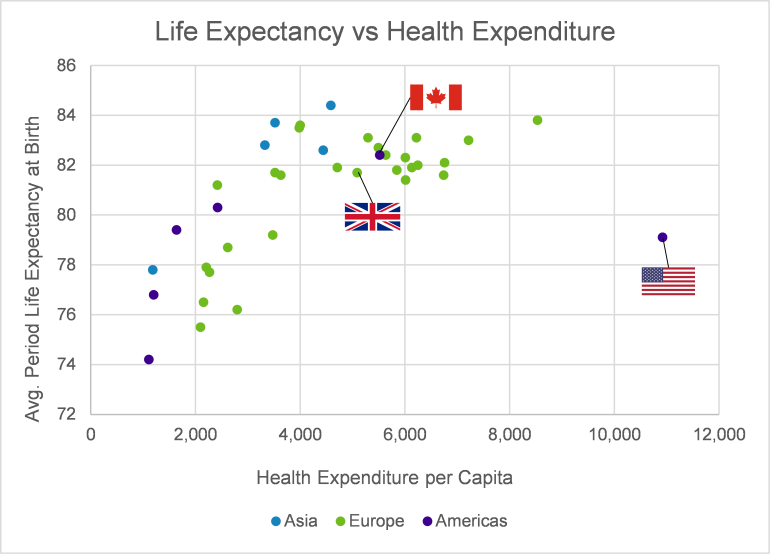Questions:
What do the provisions for cost reductions of prescription drugs included in the Inflation Protection Act of 2022 mean for health expenditure in the US and are there any ramifications for global longevity?
Answer:
These provisions are unlikely to have a significant effect on national health expenditure, however they could improve the quality of life of a significant number of over 65-year-olds across the US. There could also be some wide-reaching ramifications on the global pharmaceutical industry.
The US has long been an outlier when it comes to health spending. The chart below shows the average health expenditure per capita plotted against average period life expectancy for the 38 countries (excluding North Korea) in the OECD in 2019. Not only is the US an outlier in terms of expenditure per capita, but all this spending does not seem to have translated into health outcomes (well, at least not into increases in average period life expectancy).

Sources: LE Data - United Nations Population Division (2022); Health Care per Capita - World Development Indicators - World Bank (2022).
In an attempt to curb some of this expenditure, a number of provisions aimed at reducing the price of prescription drugs were introduced into the Inflation Reduction Act of 2022, which was signed into law in the US August 2022. The provisions focus on reducing the cost of drugs covered under Medicare, the state health insurance for the over 65s, and will limit prices paid by the government and out-of-pocket expenses paid by individuals.
These provisions are unlikely to move the needle significantly for the US position on this chart. However, there could be ramifications for the global pensions and insurance community:
- Medicare drug costs only make up around 4% of overall health expenditure in the US1, so reductions to this spending will not alter the US health expenditure per capita significantly. The Congressional Budget Office (CBO) projected a reduction in costs to Medicare of around $100bn over 10 years, which is around 0.25% of total health expenditure per year.
- The limits to out-of-pocket drug spending included in the Act could help at least 1.4 million people. This is a small proportion of the overall US population and is unlikely to significantly affect average life expectancy from birth or average health expenditure. It is around 2.5% of the over 65 population, so it is possible it could drive some modest improvements for the retired population.
- The US pharmaceutical industry makes up around 40% of the global pharmaceutical market. Limiting the money flowing into this industry and altering the incentives to create certain types of drugs, could have a wide-reaching effect on the availability of new drugs worldwide. The CBO projected a decrease of only around 1% in drugs coming to market over the next 30 years (15 fewer out of a projected 1,300). However, in reducing the revenue cycle of new drugs, the Act is likely to shift the focus of Pharma R&D to innovation over replication and widespread applications over precision medicine.
Key takeaways
- The US is a distinct outlier when looking at health expenditure by capita compared to average period life expectancy in the country.
- The introduction in of the Inflation Reduction Act of 2022 is unlikely to move the needle much for the US on this chart, but it is likely to improve the quality of life of over 1.4 million retirees in the US
- The Act will create a notable shift in incentives for global Pharma R&D that could have wide reaching effects around the world.
What do you think? Let us know in our LinkedIn discussion group Friends of Club Vita.
1 In 2019, the Centers for Medicare and Medicaid Services (CMS) estimated total health expenditure in the US to be $3.8tr, of which $800bn was due to Medicare spending, with $160bn on prescription drugs.





